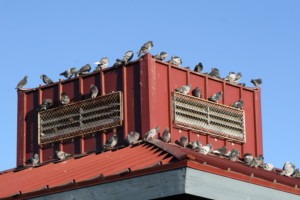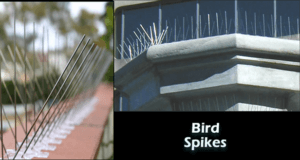Birds are graceful creatures and essential to our eco-system, but when they enter human living and working spaces, they can become pests. Commercial properties, in particular,are vulnerable to the problems associated with pest birds, their nests and their droppings.
Facts and Figures
- An apprentice elevator mechanic obtained a $2.7 million settlement from a property owner after bird droppings caused him to slip and fall down an elevator shaft.
- Bird droppings contain uric acid, which, at a pH of 3 to 4.5, can eat through most building materials.
- Like many other animals, birds are drawn to the scent of their own waste. Thoroughly cleaning and deodorizing surfaces eliminates this scent trail and discourages pest birds from following the scent back to their old roosts.
- Pest birds cause tens of millions of dollars of damage every year to machinery, automobiles, roofs and ventilation systems.
Problems Caused by Pest Birds to Commercial Properties

- noise: Many species of birds produce an incessant and irritating noise when they gather in sizeable numbers. This noise can be a nuisance to building occupants and workers and deter customers from returning to a business.
- nests: Nests can damage buildings in the following ways:
- roof damage: Starling, pigeon and sparrow nests are often built in rain gutters, drains and the underside of roof corners. Warehouses, in particular, may experience great damage, even collapsed roofs, when drainage systems are blocked and standing water is forced to rise. A collapsed roof that results in death or serious physical damage could put a company out of business.
- blocked ventilation systems: Bird nests built in chimneys and ventilation systems can not only spread diseases through the system, but they can act
 ually block airflow to the building. People can be killed by carbon monoxide poisoning when bird nests block the exhaust system.
ually block airflow to the building. People can be killed by carbon monoxide poisoning when bird nests block the exhaust system. - fires: Nests are usually flammable due to their construction of twigs, straw, and dried droppings. Nests constructed in electric signs and machinery pose a severe fire risk.
- droppings: Droppings account for some of the most visible and serious problems associated with pest birds, some of which are listed below:
- disease: Researchers have found more than 60 transmittable bird-borne diseases and dangerous parasitic organisms that can be dangerous and even fatal to humans. Humans can inhale micro-organisms contained in dried-out bird droppings when they are disturbed, leading to lung diseases such as histoplasmosis. Toxoplasmosis and query fever can develop when humans ingest foods that have come into contact with bird-related bacteria. Also, property-destroying and disease-laden insects and mites are found on birds, their droppings and nesting materials.
- property: Left undisturbed, bird waste can damage almost any building material. Wood, stone, steel and iron can all be damaged by bird droppings, which have a pH level similar to vinegar. If allowed to accumulate, droppings can clog gutters, discolor paint, corrode I-beams, ruin cloth awnings, and short out electrical equipment. Droppings commonly eat into and destroy wood, paper and cardboard packaging of products stored outdoors on pallets.
- roofs: Bird droppings can eat away at many substrates, especially tar-based roofing materials. Droppings that are allowed to accumulate on roofs will eat into the material and eventually cause leaks. The life expectancy of a warehouse roof can be cut in half by a light, but continuous, layer of bird droppings.
- machinery: Bird droppings can do heavy damage to air-conditioning equipment and industrial machinery. Also, workers are put at risk any time they work on or around machinery contaminated by bird droppings.
- automobile finishes: Most bird droppings will fade paint finishes by eating into the protective coating and the paint itself. The longer the droppings are allowed to sit on the paint, the more damage they will do. Customers whose cars are defaced by bird droppings are less likely to return to that place of business!
- live birds: Birds that enter building interiors can wreak havoc on commercial operations. Large, open areas, such as the insides of warehouses, airplane hangars, malls, factories and convention centers are often home to pest birds. Bird droppings can ruin plastics when they are being molded, destroy any number of chemicals and liquids that are being manufactured, ruin paint jobs on aircraft, and contaminate food that is being made or packaged. Droppings also spoil finished products in loading bays and storage areas. And, of course, droppings can rain down of the heads of customers and employees who are in the building. This latter issue can be of particular severity at indoor concerts, sporting events and in malls.
- company image: Droppings on or around a building convey to the public that the building is not properly maintained. Prospective customers may wonder how clean a restaurant’s kitchen could be if bird droppings are dripping down the side of the building.
- slips and falls: Bird droppings, which are slippery when fresh, may cause pedestrians, customers and/or employees to slip at such places as building entrances and fire escapes. Commercial property owners who fail to prevent bird infestation may be prone to huge legal liabilities.
Although International Standards of Practice for Inspecting Commercial Properties do not require inspectors to determine the presence of birds, they still may be knowledgeable about bird infestation and deterrence. Consult with a CCPIA inspector during your next scheduled inspection to find out the extent of the problem and possible corrective measures.
Bird Deterrence Methods
Unlike homes and boats, commercial buildings can suffer damage from pest birds on a grand scale. The only viable solution is bird-proofing, which involves denying the birds access to nesting and roosting areas of a structure. This can be accomplished with products that make it uncomfortable for birds to roost in a particular area, or with products that make it physically impossible for birds to access the structure. The following options are available to commercial property owners who wish to be free of pest birds:
 “porcupine wire” or “bird spikes”: This simple, effective, and inexpensive bird-control method dates back to 1950, when newly invented porcupine-wire strips were installed on the structures of President Dwight D. Eisenhower’s farm near Gettysburg, Pennsylvania. They are available in species-specific sizes.
“porcupine wire” or “bird spikes”: This simple, effective, and inexpensive bird-control method dates back to 1950, when newly invented porcupine-wire strips were installed on the structures of President Dwight D. Eisenhower’s farm near Gettysburg, Pennsylvania. They are available in species-specific sizes.- pin and wire systems: Birds will not land on these tight strands of wire. Installation of this system can be very labor-intensive and should only be used for repelling large birds. These systems work best when covering very narrow surfaces, such as railings, along balconies, and where there is moderate human activity. Some systems can now transmit a low-voltage current through the wires to help repel birds.
- scare-away devices: Of the various scare-away devices available, balloons may be the most effective because they move around with the wind. It may be helpful to frequently change balloon position and color to help prevent birds from becoming
accustomed to them.  sticky paste and liquid repellents: These types of products are non-drying, non-toxic, sticky substances that are spread onto a surface. The compound tends to irritate birds’ feet so that they leave the protected area.
sticky paste and liquid repellents: These types of products are non-drying, non-toxic, sticky substances that are spread onto a surface. The compound tends to irritate birds’ feet so that they leave the protected area.- safe chemical bird repellents: Use safe chemical bird repellents that are regulated by the U.S. Environmental Protection Agency under the Federal Insecticide, Fungicide and Rodenticide Act (FIFRA). When a bird is exposed to a chemical bird repellent, they temporarily experience pain. The birds suffer no permanent harm, but they will associate the pain stimulus with the site and learn that the area is not desirable.
- bird netting: Netting is a good choice for access prevention. If you have an open warehouse, a building, or an overhang where birds get up into the rafters and beams, bird netting is an effective, economical choice. Netting should be strong and lightweight,
 with 3/4-inch square openings or smaller. Larger openings may not prevent sparrows and other small birds from passing through.
with 3/4-inch square openings or smaller. Larger openings may not prevent sparrows and other small birds from passing through.
Note: Before purchasing a bird-control system, identify the types and number of birds causing the problem. Make note of the areas where birds are landing and roosting. If the birds are not present at the time of inspection, look for nests and droppings on the building, sidewalks, awnings, and signs. Also, look for and eliminate any nearby water or food sources.
In summary, pest birds can damage property and endanger human health. Commercial property owners should discuss with a CCPIA inspector if they suspect they have a problem with pest birds.

